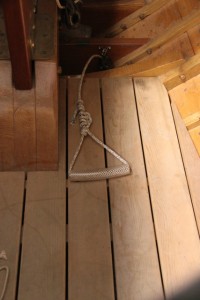New Bilge Pump
Replaced the diagram bilge pump with a double action Gusher 30 bilge pump which not only pumps a lot more water as it acts on both strokes but is also significantly larger in size – it was quiet a trick to install this pump. It is now place just above the deepest point of the bilge and pumps the water right from there. A strainer was also added.
The “exit-hose” for the new bilge pump is permanently installed – no more need to fiddle around with a hose over the covering boards. The exit is on the deck, just aft of the tiller. Jamie thought-up a mechanism that allows the pump to be operated from a defined point independent from the pump and includes shock cords which in turn allows the operator to only pull one stroke and have the shock cord take care of the counter stroke – with water being pumped on both strokes.

The “pull cord” for the pump is located next to the mast step on starboard, all mechanics are hidden under the sole.

Transport Covers
About 10 days ago, Kinder Industries was back at the shop with the transport cover for LUCIE for a trial fitted. All went well, everyone is happy with the results. We now have three additional things on their list:
1. The cover for the mast and boom has to be fitted. As we had the mast and boom on the spar rack we decided to do that fitting next week.
2. The boom tent still needs to be adjusted. With LUCIE going into the water in Bristol in early May for practice sessions, we decided that the most accurate fitting can be done with the boat fully rigged so this adjustment will then happen early May.
3. The transport cover still needs extra padding in the areas where the new mast cradles will be placed. This triggered a small change in our schedule. We pulled the building of the mast cradles ahead to allow Kinder to measure for the padding. There will be four cradles that carry the mast and boom on top of the boat. The cradles are fit to the camber of the boat in the defined positions (each camber is different). The cradles are designed in such a way that 2″ tie-down straps fit inside them. The position of the cradles on deck therefore is defined by the pad-eyes on the trailer for the tie downs. We will upgrade from two straps last season to four straps next season to spread the load. The pictures below show the cradle bases on the deck. The fittings for the mast will be added soon and then the cradles will be painted white.



Trailer
We had originally followed the idea to grind down the forward trailer mast fork to take out the sharp edge that caused the damages to the mast during transport last year both to Finland and then again from Finland. (The trailer fork sits at an angle thereby causing one of the edges to stick-up). But grinding down any metal surface on the trailer would have meant to damage the galvanization of the surface. Therefore, we decided to drop the idea of grinding the fork flat and instead have added a soft wood wedge to the trailer mast fork that takes out the sharp edge and provides a 3″ flat surface for the mast to sit in. A carpet like padding will also be added.

Primary Winches
The primary winches and the corresponding cleats have been moved 16″ further forward for better trimming ergonomics.

Hull
We identified all high and low spots on the hull from the laser analysis and have started the fairing process: all low spots on the bottom have been sanded and filled with fairing compound – the bottom is now ready for longboarding. The topsites have already received a very light longboarding and are being prepared for fresh topsite paint. Topsite paint will be applied once all works on deck are finished – including the work on the mast partner and step.


Headstay Slot
The headstay slot at the bow has received two D-shape gaskets and is now tight as a drum. This should prevent water from coming through this slot, as it did in Finland at the World Cup. (No more duct tape!)

Helmsman Bench
We checked various alternatives for the helmsman bench – unfortunately there is nothing “lighter” than the current 11 lbs bench made from Cedar (at least not in wood). Jamie checked and tried the bench and likes it…
Mast
I also contacted Jacob regarding the jib halyard sheave box and the half round at its bottom: Jacob confirmed that it is supposed to slightly stick out of the mast surface to act as a chafe guard. The mast has by now received one full coat of varnish, but as there might be some changes coming to the bottom of the mast with the revised mast step design. Therefore, we are holding-off on the last coat of varnish. We however went through each of the sheave boxes again to ensure that they are completely sealed-off. The inside of the mast cut-outs has been sealed before installation. There will however always be some water (rainwater mostly) getting into the mast thru the sheave itself, but the hollow mast is sealed on the inside and has a small drain hole at the bottom to release any water that is finding its way in.





Speak Your Mind